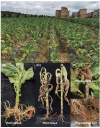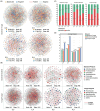Changes in the community composition and function of the rhizosphere microbiome in tobacco plants with Fusarium root rot
- PMID: 40291803
- PMCID: PMC12023262
- DOI: 10.3389/fmicb.2025.1512694
Changes in the community composition and function of the rhizosphere microbiome in tobacco plants with Fusarium root rot
Abstract
Introduction: Tobacco root rot caused by Fusarium spp. is a soil-borne vascular disease that severely affects tobacco production worldwide. To date, the community composition and functional shifts of the rhizosphere microbiome in tobacco plants infected with Fusarium root rot remain poorly understood.
Methods: In this study, we analyzed the differences in the compositions and functions of the bacterial and fungal communities in the rhizosphere and root endosphere of healthy tobacco plants and tobacco with Fusarium root rot using amplicon sequencing and metagenomic sequencing.
Results and discussion: Our results showed that Fusarium root rot disrupted the stability of bacteria-fungi interkingdom networks and reduced the network complexity. Compared to healthy tobacco plants, the Chao1 index of bacterial communities in the rhizosphere soil of diseased plants increased by 4.09% (P < 0.05), while the Shannon and Chao1 indices of fungal communities decreased by 13.87 and 8.17%, respectively (P < 0.05). In the root tissues of diseased plants, the Shannon index of bacterial and fungal communities decreased by 17.71-27.05% (P < 0.05). Additionally, we observed that the rhizosphere microbial community of diseased tobacco plants shifted toward a pathological combination, with a significant increase in the relative abundance of harmful microbes such as Alternaria, Fusarium, and Filobasidium (89.46-921.29%) and a notable decrease in the relative abundance of beneficial microbes such as Lysobacter, Streptomyces, Mortierella, and Penicillium (48.48-81.56%). Metagenomic analysis further revealed that the tobacco rhizosphere microbial communities of diseased plants played a significant role in basic biological metabolism, energy production and conversion, signal transduction, and N metabolism, but their functions involved in C metabolism were significantly weakened. Our findings provide new insights into the changes in and interactions within the rhizosphere and root endosphere microbiomes of tobacco plants under the stress of Fusarium soil-borne fungal pathogens, while laying the foundation for the exploration, development, and utilization of beneficial microbial resources in healthy tobacco plants in the future.
Keywords: Fusarium spp.; microbial diversity; microbial interactions; rhizosphere; soil-borne fungal disease.
Copyright © 2025 Yang, Cai, Bai, Han, Zeng, Liu, Liu, Liu, Ma and Yu.
Conflict of interest statement
YC, TB, RZ, DL, TL, RL, and CM were employed by Qujing Branch of Yunnan Provincial Tobacco Company. The remaining authors declare that the research was conducted in the absence of any commercial or financial relationships that could be construed as a potential conflict of interest.
Figures







Similar articles
-
Root rot destabilizes the Sanqi rhizosphere core fungal microbiome by reducing the negative connectivity of beneficial microbes.Appl Environ Microbiol. 2024 Mar 20;90(3):e0223723. doi: 10.1128/aem.02237-23. Epub 2024 Feb 5. Appl Environ Microbiol. 2024. PMID: 38315008 Free PMC article.
-
Differences in Soil Microbial Communities between Healthy and Diseased Lycium barbarum cv. Ningqi-5 Plants with Root Rot.Microorganisms. 2023 Mar 8;11(3):694. doi: 10.3390/microorganisms11030694. Microorganisms. 2023. PMID: 36985267 Free PMC article.
-
Zanthoxylum bungeanum root-rot associated shifts in microbiomes of root endosphere, rhizosphere, and soil.PeerJ. 2022 Aug 4;10:e13808. doi: 10.7717/peerj.13808. eCollection 2022. PeerJ. 2022. PMID: 35945942 Free PMC article.
-
Root Niches of Blueberry Imprint Increasing Bacterial-Fungal Interkingdom Interactions along the Soil-Rhizosphere-Root Continuum.Microbiol Spectr. 2023 Jun 15;11(3):e0533322. doi: 10.1128/spectrum.05333-22. Epub 2023 May 24. Microbiol Spectr. 2023. PMID: 37222589 Free PMC article.
-
Effects of Rhizosphere Microbial Communities on Cucumber Fusarium wilt Disease Suppression.Microorganisms. 2023 Jun 14;11(6):1576. doi: 10.3390/microorganisms11061576. Microorganisms. 2023. PMID: 37375078 Free PMC article.
References
-
- Ahmed W., Dai Z., Liu Q., Munir S., Yang J., Karunarathna S. C., et al. . (2022). Microbial cross-talk: dissecting the core microbiota associated with flue-cured tobacco (Nicotiana tabacum) plants under healthy and diseased state. Front. Microbiol. 13:845310. 10.3389/fmicb.2022.845310 - DOI - PMC - PubMed
LinkOut - more resources
Full Text Sources
Miscellaneous

